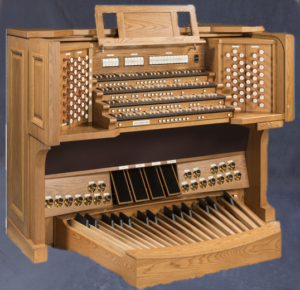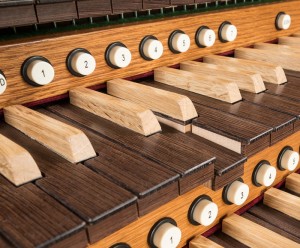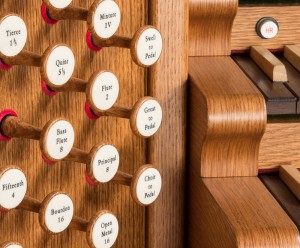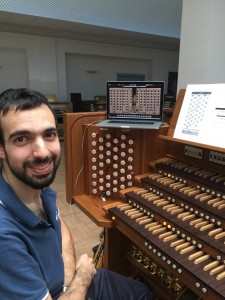It is always a joy to see a number of our loyal customers upgrading instruments over time as they move from 2 to 3 manuals or from older technology to the very latest we have available. Some of our customers even have more than one instrument!
It is rare though to have the pleasure of working with a customer to plan a very special drawstop instrument.
In this case our customer was Philip Meaden, the current chief executive of the Royal College of Organists. He is a very active performer and so home practice facilities are important. He also is a keen user of Hauptwerk which he plays through his Viscount Organ and additional external speakers and using this facility is in part what drove the design of the new instrument we supplied earlier this year.
 One of Philip’s favourite Hauptwerk sets is the Laurenskerk in Holland. This is a massive instrument with an extraordinarily large pedal department of 20 stops. The instrument has 86 speaking stops in total spread over 5 manual divisions played from 4 keyboards. Our challenge was to build a console that would comfortably drive that Hauptwerk sample set and also include a comprehensive set of ‘Physis’ stop models so it would play as a conventional Viscount organ as well.
One of Philip’s favourite Hauptwerk sets is the Laurenskerk in Holland. This is a massive instrument with an extraordinarily large pedal department of 20 stops. The instrument has 86 speaking stops in total spread over 5 manual divisions played from 4 keyboards. Our challenge was to build a console that would comfortably drive that Hauptwerk sample set and also include a comprehensive set of ‘Physis’ stop models so it would play as a conventional Viscount organ as well.
The standard Viscount 4 manual instrument is designed for 69 speaking stops so we had to fit in 17 additional voices onto the jambs. One of my pet concerns when laying out a console is to ensure that as far as possible there is good separation between the divisions and that the couplers are placed logically within the divisions or otherwise totally separate often above the swell rail. This is also one of the first instruments into the UK to incorporate keyboards made by Viscount rather than Fatar. They are solid wood and adjustable for both weight and top resistance point. You can see the  keys in more detail in this picture.
keys in more detail in this picture.
Philip agreed with this approach and our solution for this substantial instrument was to use the space above the swell for the 12 speaking stops of the Solo manual and also the 6 stops for the Bombarde played from the 3rd manual at Laurenskerk but in our instrument played from the Solo. We also placed the midi activation stops above the swell.
Pedal couplers sit adjacent to the manuals in the pedal department jamb and the inter manual couplers on the right jamb adjacent to the manuals and also forming a division between the 2 departments of the jamb.
The pedal department of the Laurenskerk instrument is perhaps the most unusual not just because of its size but also for some of the stops. It has a  Mixture X (ten ranks) and also a Flute 1ft stop. Do you know of any other instruments with these unusual ingredients on the pedals?
Mixture X (ten ranks) and also a Flute 1ft stop. Do you know of any other instruments with these unusual ingredients on the pedals?
Here is the stop list which we replicated on Philip’s organ.
With such a large and unusual instrument I decided that a visit to Italy just prior to shipment with Philip would be good to ensure that all the special features were correctly installed would be a good idea, not that I need any excuse to plan a trip to Italy.
 In the event it was a good decision as after review at the console we added an additional piston that switches off all the internal physis voices and so quickly converts the console to be the Hauptwerk only platform that Philip from time to time requires. Here you see Massimo checking out the final Hauptwerk functions before the Instrument left Italy
In the event it was a good decision as after review at the console we added an additional piston that switches off all the internal physis voices and so quickly converts the console to be the Hauptwerk only platform that Philip from time to time requires. Here you see Massimo checking out the final Hauptwerk functions before the Instrument left Italy
A final feature of this instrument is a split console essential for delivery into Philips music room and for halving the weight that had to be carried. This is Philip’s 3rd Viscount organ over the years. We look forward to what he might like for his next one!
I have had a passion for church organs since the tender age of 12. I own and run Viscount Organs with a close attention to the detail that musicians appreciate; and a clear understanding of the benefits of digital technology and keeping to the traditional and emotional elements of organ playing.



